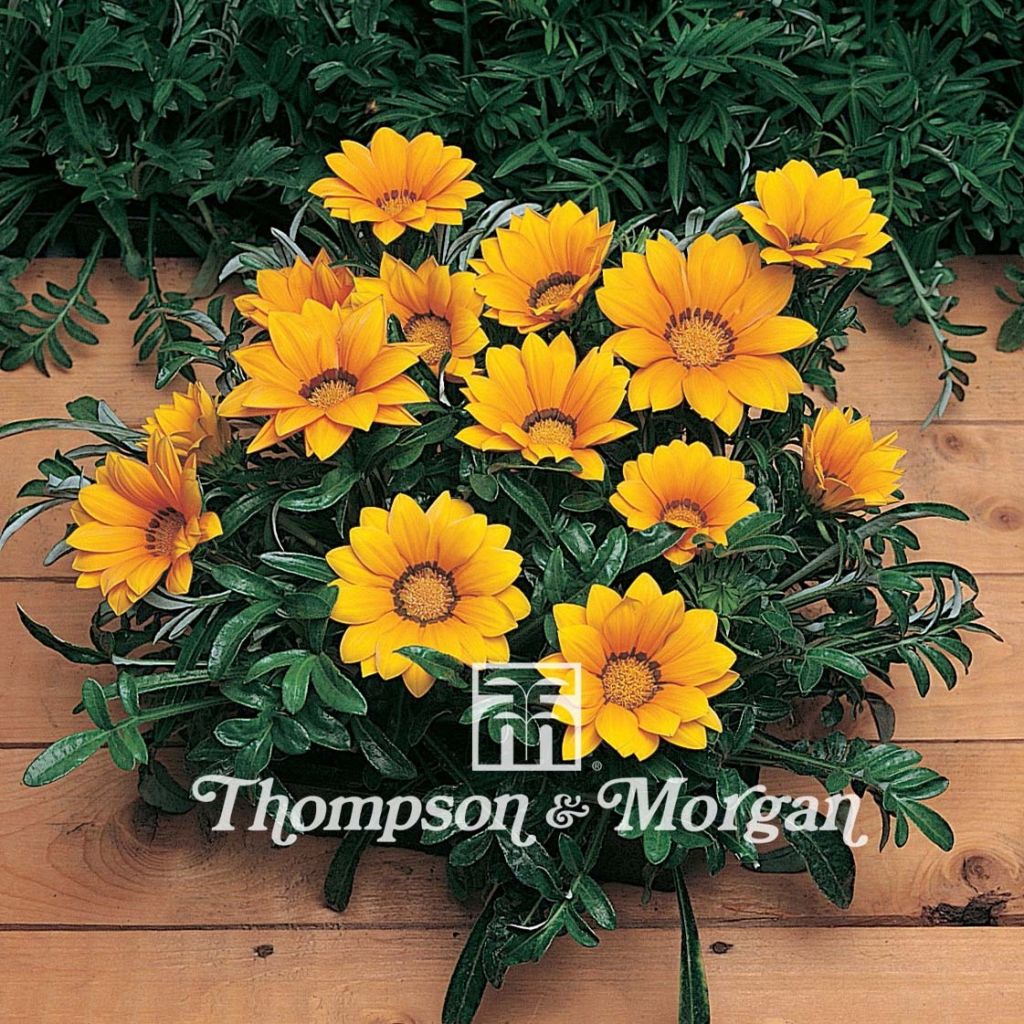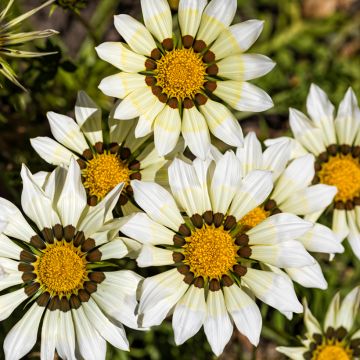

Gazania rigens Kiss Gold F1 - Treasure flower
Gazania rigens Kiss Gold F1 - Treasure flower
Gazania rigens Kiss Gold F1
Treasure flower
Special offer!
Receive a €20 voucher for any order over €90 (excluding delivery costs, credit notes, and plastic-free options)!
1- Add your favorite plants to your cart.
2- Once you have reached €90, confirm your order (you can even choose the delivery date!).
3- As soon as your order is shipped, you will receive an email containing your voucher code, valid for 3 months (90 days).
Your voucher is unique and can only be used once, for any order with a minimum value of €20, excluding delivery costs.
Can be combined with other current offers, non-divisible and non-refundable.
Why not try an alternative variety in stock?
View all →This plant carries a 6 months recovery warranty
More information
We guarantee the quality of our plants for a full growing cycle, and will replace at our expense any plant that fails to recover under normal climatic and planting conditions.
Would this plant suit my garden?
Set up your Plantfit profile →
Description
Gazania Kiss Gold F1 is a new variety selected for its compact habit and extraordinary floribundity. Not even cool weather can stop this plant blooming. Its small size contrasts with its large, golden daisy-like flowers, a radiant colour further accentuated by a small dark circle around the heart. They bloom tirelessly, from spring to the first frost, bringing life to sunny borders and planters. Outside of Mediterranean regions, it can be easily grown as an annual plant.
Gazania rigens, also known as treasure flower, belongs to the large Asteraceae family. It is native to South Africa and Mozambique. The type species bears sun-yellow flower heads around an orange heart speckled with black and brown. It is an herbaceous perennial plant, typically grown as an annual in cool and humid climates.
Gazania Kiss Gold F1 is a compact cultivar from the Kiss series, with flowers that have increased in size and brilliance. The plant forms a small clump of leafy stems within a few weeks, not exceeding 20cm (8in) in all directions. The early and prolonged flowering lasts from May to October if faded flowers are regularly removed. Solitary inflorescences resembling large daisies, 6 to 7cm (2 to 3in) in diameter, form at the ends of the branched stems. Each one has a double row of ligulate outer florets arranged in a staggered pattern, with a golden yellow colour and dark brown markings at the base. This collar of outer florets surrounds a centre composed of tubular central florets, giving it a velvety appearance. The flowers tend to close when the sun is hidden. The basal leaves are ovate and leathery. They are fairly dark green and shiny on the upper surface, and silver-grey on the underside.
Gazania Kiss Gold F1 should be planted in small groups along the edges of flower beds, paired with taller and monochromatic plants. It thrives in rock gardens and on banks, as well as in raised beds. Kiss Gold F1 is perfect in pots on a patio. It must be planted in full sun, otherwise the flowers will not open. Busy gardeners will appreciate it for its beauty and simplicity. It prefers sandy or very well-drained soils. It can withstand long periods of drought, but it does not tolerate stagnant moisture. Water it sparingly but regularly and it will be even more beautiful.
Report an error about the product description
Flowering
Foliage
Plant habit
Botanical data
Gazania
rigens
Kiss Gold F1
Asteraceae
Treasure flower
Cultivar or hybrid
Other Gazania seeds
View all →Planting and care
Soak the seeds for a few hours before sowing. Sow under glass from February to April. Cover them with 3mm of a mixture of soil and sand. Keep them in a warm place, ideally with a temperature ranging between 18 and 25°C (64.4 to 77°F). Keep the soil slightly moist but without excess. You will need to wait 14 to 30 days to see the young seedlings appear. When they are large enough to handle, transplant them into pots and acclimatise them for about ten days. After that, plant them in open ground when there is no risk of frost. Space each plant 20 to 30cm (8 to 12in) apart.
Grow them in full sun. They like ordinary but well-drained soil, possibly lightened with gravel, sand, and compost. Gazanias fear stagnant moisture, so avoid leaving water-filled saucers under the pots. A special flowering plant fertiliser will be appreciated.
Sowing period
Intended location
This item has not been reviewed yet - be the first to leave a review about it.
Similar products
Haven't found what you were looking for?
Hardiness is the lowest winter temperature a plant can endure without suffering serious damage or even dying. However, hardiness is affected by location (a sheltered area, such as a patio), protection (winter cover) and soil type (hardiness is improved by well-drained soil).

Photo Sharing Terms & Conditions
In order to encourage gardeners to interact and share their experiences, Promesse de fleurs offers various media enabling content to be uploaded onto its Site - in particular via the ‘Photo sharing’ module.
The User agrees to refrain from:
- Posting any content that is illegal, prejudicial, insulting, racist, inciteful to hatred, revisionist, contrary to public decency, that infringes on privacy or on the privacy rights of third parties, in particular the publicity rights of persons and goods, intellectual property rights, or the right to privacy.
- Submitting content on behalf of a third party;
- Impersonate the identity of a third party and/or publish any personal information about a third party;
In general, the User undertakes to refrain from any unethical behaviour.
All Content (in particular text, comments, files, images, photos, videos, creative works, etc.), which may be subject to property or intellectual property rights, image or other private rights, shall remain the property of the User, subject to the limited rights granted by the terms of the licence granted by Promesse de fleurs as stated below. Users are at liberty to publish or not to publish such Content on the Site, notably via the ‘Photo Sharing’ facility, and accept that this Content shall be made public and freely accessible, notably on the Internet.
Users further acknowledge, undertake to have ,and guarantee that they hold all necessary rights and permissions to publish such material on the Site, in particular with regard to the legislation in force pertaining to any privacy, property, intellectual property, image, or contractual rights, or rights of any other nature. By publishing such Content on the Site, Users acknowledge accepting full liability as publishers of the Content within the meaning of the law, and grant Promesse de fleurs, free of charge, an inclusive, worldwide licence for the said Content for the entire duration of its publication, including all reproduction, representation, up/downloading, displaying, performing, transmission, and storage rights.
Users also grant permission for their name to be linked to the Content and accept that this link may not always be made available.
By engaging in posting material, Users consent to their Content becoming automatically accessible on the Internet, in particular on other sites and/or blogs and/or web pages of the Promesse de fleurs site, including in particular social pages and the Promesse de fleurs catalogue.
Users may secure the removal of entrusted content free of charge by issuing a simple request via our contact form.
The flowering period indicated on our website applies to countries and regions located in USDA zone 8 (France, the United Kingdom, Ireland, the Netherlands, etc.)
It will vary according to where you live:
- In zones 9 to 10 (Italy, Spain, Greece, etc.), flowering will occur about 2 to 4 weeks earlier.
- In zones 6 to 7 (Germany, Poland, Slovenia, and lower mountainous regions), flowering will be delayed by 2 to 3 weeks.
- In zone 5 (Central Europe, Scandinavia), blooming will be delayed by 3 to 5 weeks.
In temperate climates, pruning of spring-flowering shrubs (forsythia, spireas, etc.) should be done just after flowering.
Pruning of summer-flowering shrubs (Indian Lilac, Perovskia, etc.) can be done in winter or spring.
In cold regions as well as with frost-sensitive plants, avoid pruning too early when severe frosts may still occur.
The planting period indicated on our website applies to countries and regions located in USDA zone 8 (France, United Kingdom, Ireland, Netherlands).
It will vary according to where you live:
- In Mediterranean zones (Marseille, Madrid, Milan, etc.), autumn and winter are the best planting periods.
- In continental zones (Strasbourg, Munich, Vienna, etc.), delay planting by 2 to 3 weeks in spring and bring it forward by 2 to 4 weeks in autumn.
- In mountainous regions (the Alps, Pyrenees, Carpathians, etc.), it is best to plant in late spring (May-June) or late summer (August-September).
The harvesting period indicated on our website applies to countries and regions in USDA zone 8 (France, England, Ireland, the Netherlands).
In colder areas (Scandinavia, Poland, Austria...) fruit and vegetable harvests are likely to be delayed by 3-4 weeks.
In warmer areas (Italy, Spain, Greece, etc.), harvesting will probably take place earlier, depending on weather conditions.
The sowing periods indicated on our website apply to countries and regions within USDA Zone 8 (France, UK, Ireland, Netherlands).
In colder areas (Scandinavia, Poland, Austria...), delay any outdoor sowing by 3-4 weeks, or sow under glass.
In warmer climes (Italy, Spain, Greece, etc.), bring outdoor sowing forward by a few weeks.





















































